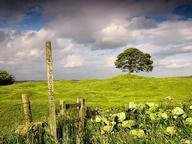Quiz Answer Key and Fun Facts
1. This small village is situated about eight miles from Derby, on an old Roman road. It rests comfortably on a stream that is crossed by two bridges. This quaint little village also has the Ostrich Pub, which holds the Coke family Coat of Arms. What is the name of this village?
2. This village is situated at approximately 1200 feet above sea level, and is about four miles South East of Buxton. In this village you will find the Church of Saint John the Baptist, which dates back to the early 13th Century. It also hosts an annual "Well Dressing" in June. What is the name of this village?
3. This large village is situated near A6, which runs through the centre of the village, and is approximately four and a half miles north of Derby. Located near the centre of the village there is "Castle Hill," which is a remnant of a castle that is believed to have been built by Henry de Ferres, the Earl of Derby. You will also find the Church of St. Alkmunds and the Kings Head Inn. What is the name of this village?
4. This village is located in the Peak District National Park, and rests high atop the White Peak plateau. Also found in this village is the Church of All Saints and the Duke of York Pub. What is the name of this village?
5. This small village can be found on a hillside approximately one mile from Crich. Almost the entire village lies between the Amber River, which can be found at the foot of the hill, and the Cromford Canal, which is directly under the main road. There is also an additional bridge, built by George Stevenson in 1840, that carries main line trains from Derbyshire to Sheffield. The largest manufacturer in this village was Stevenson's Dye Works, and also has the Lord Nelson Pub. What is the name of this village?
6. This picturesque village is an estate village, and most of the buildings that can be found here date back to around 1850. Industrialist Francis Wright and his family once lived here and owned the Butterley Ironworks. You will also see the St. Martins Parish Church, which was built in 1845. What is the name of this village?
7. This village, located in the Peak District, has charisma and presence and a very large main street. Every year in June or July, this village holds its annual Wakes Week, where the men of the village perform dances. If you follow the A6 out of Matlock heading towards Bakewell, then take a left turn onto the B5057 you will be in this distinctive village. What is the name of this village?
8. This village is known for being an attractive village and is approximately six miles North East of Derby. In 1610, the Richardson family helped to establish this pretty village by purchasing an estate farm. In the early part of the eighteenth century, brothers John and Samuel Richardson started a colliers charity to help benefit miners of the village. The brothers also started a program in which they chose twelve schoolboys and paid for their education. In 1956, the Round house, which was an old-fashioned tollhouse, was demolished. What is the name of this village?
9. This small village lies on the Trent River, which is approximately five miles south of Derby. In this village you will also find St. Andrews Church and contains statues, which are dedicated to the Harpur family. What is the name of this village?
10. This village is primarily considered a coal-mining village, and has a few acres of land in Nottinghamshire. In the early part of the nineteenth century, a railway was built from this village's wharf to Mansfield. It was horse drawn until 1849, when it was connected to the Erewash Valley Railway. You can also find the Church of St. Helen, which was built in 1750. What is the name of this village?
Source: Author
JuniorTheJaws
This quiz was reviewed by FunTrivia editor
minch before going online.
Any errors found in FunTrivia content are routinely corrected through our feedback system.
